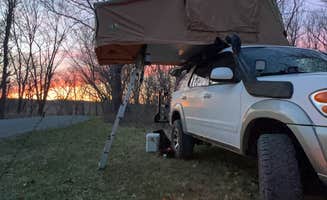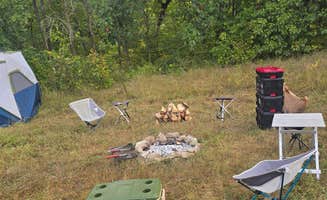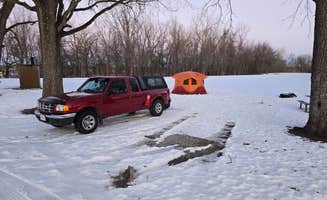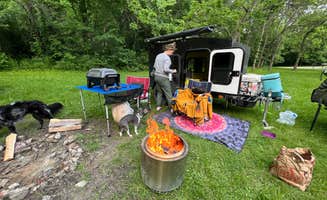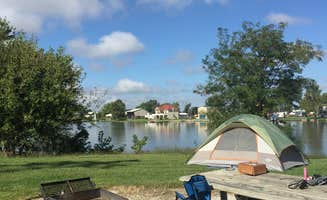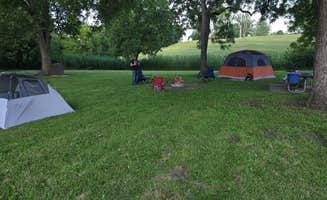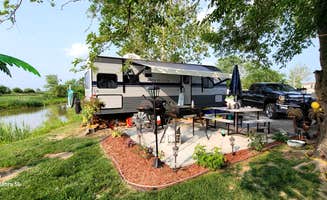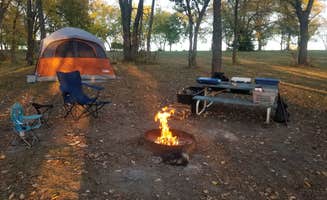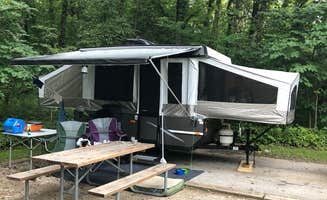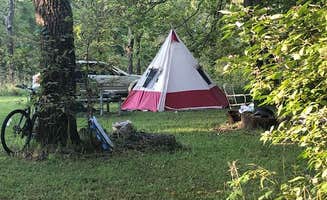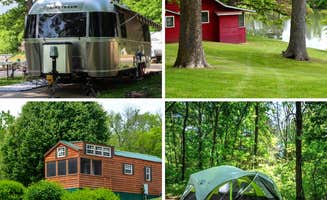Camping options near Amazonia, Missouri center around the Missouri River basin at approximately 800 feet elevation, offering campers access to both wooded conservation areas and riverside camping opportunities. The region experiences distinct seasonal changes with hot, humid summers where temperatures typically reach 85-90°F and cold winters that can drop below freezing. Access roads to most camping areas are unpaved and can be challenging during spring rain events when the Missouri River occasionally reaches flood stage.
What to do
Fishing at multiple access points: Rochester Falls Access in Helena provides river access with a natural beach area where campers can fish and collect interesting minerals. "I was amazed at this pocket of scenic beauty. When I arrived, the other campers were kind and helpful. The easy access to the beach there is incredibly helpful and the fishing was great. As a Rockhound, I found so many beautiful and unique minerals and made a lot of jewelry from it," notes a camper at Rochester Falls Access.
Hiking forest trails: Explore the network of trails through deciduous forests at conservation areas like Happy Holler. "We camped at the south section of Happy Holler Conservation Area, and it's a great spot if you're looking for a real dispersed camping experience. We chose a site tucked right between a fishing pond and a river, which gave us beautiful views and easy access to the water," reports one visitor to Happy Holler Conservation Area South.
Wildlife observation: Birding opportunities are available throughout the conservation areas along the Missouri River flyway. Elrod Mill Access offers primitive camping with wildlife viewing opportunities. "Elrod Mill Conservation Area is a quiet, hidden gem for anyone who enjoys dispersed camping. Fishing access is available as well, which makes it a nice combination of camping and recreation," according to one camper review.
What campers like
Affordability of conservation areas: Many campers appreciate the free camping options in the area. At Honey Creek Conservation Area in Amazonia, a camper noted, "Google Maps will take you on some gnarly gravel roads in a big loop if you take directions straight from Dyrt. Save yourself the time and search 'Honey Creek Conservation Area'. The spot itself is decent. It's free. The campsites were super clean, but the bathrooms leave much to be desired."
Privacy at less-developed sites: Many conservation areas offer more secluded camping than established campgrounds. "A good spot if you are not interested in a busy campground. This is a beautiful wooded conservation area. We stayed at camp area 3 which is way more wooded and deep inside the conservation area with access to the river right on the site," reports a camper about Honey Creek Conservation Area.
Riverfront locations: Several camping areas provide direct access to the Missouri River or its tributaries. One Rochester Falls Access camper shared, "Camped here twice on weekdays and nobody else was here. Quiet, peaceful, and clean. There is a bathroom and is close to the river."
What you should know
Variable road conditions: Access roads to conservation areas can be challenging. A visitor to Arthur Dupree Memorial Conservation Area reported, "We attempted to post up at Dupree on the river for our inaugural spring camping trip, but was not able to enter the CA the usual way from St. Joseph off Highway 36. Our first attempt at entering was via the North on Airport Road, but that led us to a locked gate with a sign that said something about a levee."
Limited facilities at conservation areas: Most conservation areas have minimal amenities. "There aren't any amenities—no bathrooms, no picnic tables, no hookups—so you'll need to come prepared and be self-sufficient," notes a camper about Elrod Mill Access.
Seasonal closures: Some areas may close temporarily due to flooding or infrastructure work. "We couldn't access due to levee digging," reported one visitor to Arthur Dupree Memorial Conservation Area, showing that access can change based on maintenance projects.
Tips for camping with families
Choose established campgrounds for amenities: For families with young children, campgrounds with bathrooms and defined sites may be preferable. The AOK Campground & RV Park in St. Joseph offers additional facilities like a pool: "The pool was small but was clean and fenced," noted one reviewer.
Consider weather impacts: Summer temperatures in the region can reach uncomfortable levels. "We travel with a dog and so much lush green grass to explore and walk was a plus for us. There is a dog park but I didn't look for it so can't comment on it," shared a camper about pet-friendly considerations at AOK Campground during warm weather.
Scout tent-specific areas: Some campgrounds have designated tent areas that may be more comfortable. A reviewer at AOK Campground mentioned, "They have a few tent sites that looked very nice. Site A was really tucked into the back and had lots of vegetation and privacy."
Tips from RVers
Best places to camp near Amazonia for RVs: Full-hookup options are limited but available. "We booked at the last minute while traveling through and heading home. When we came in after hours, we had our envelope ready with a map and route to our campsite. The campsites were nice, level gravel sites," reported an RVer at AOK Campground.
Check site length limitations: Conservation areas typically accommodate smaller rigs. At Rochester Falls Access, a camper noted, "Not really big rig friendly. One site, maybe. We got ours (43.5') in, barely. It's the first site out of the 6 or 7 here. Great for 30' travel trailers."
Consider overnight alternatives: For those just passing through, Love's RV Hookup in St. Joseph offers basic overnight parking. "We arrived around midnight and there was very limited parking. We did not plan to use the RV hook ups but there seemed to still be one available slot if we wanted it," shared one overnight visitor.


